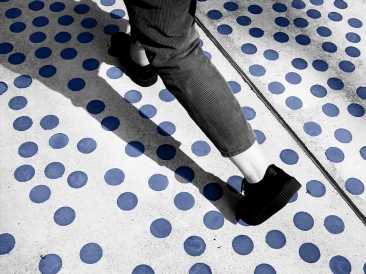
- As many as 500,000 people around the world injure their spinal cord each year.
- Spinal cord injuries account for more than 27% of all paralysis cases in the United States each year.
- Researchers from the NeuroRestore research center at the École polytechnique fédérale de Lausanne (EPFL) in Switzerland have identified specific neurons that when activated help restore a person’s ability to stand up and walk after paralysis.
As many as 500,000 people around the world each year experience a spinal cord injury. Depending on the severity of the injury, it can cause paralysis and affect a person’s ability to move and walk.
In the United States, about 5.4 million people live with some type of paralysis, with spinal cord injuries causing 27.3% of those cases.
Now, researchers from the NeuroRestore research center at the École polytechnique fédérale de Lausanne (EPFL) in Switzerland have identified specific neurons that, when activated, help restore a person’s ability to stand up and walk after paralysis.
This study recently appeared in the journal Nature.
Why does spinal cord injury lead to paralysis?
The spinal cord is a large tract of nerves that runs vertically in the middle of a person’s back and is part of the central nervous system. At the top, it connects to the brain, and at the bottom to the lower back.
Because of its connection to the brain, the spinal cord is responsible for carrying messages from the brain that tell the limbs to move and helps control body functions such as breathing and heart rate. The spinal cord also relays messages from various body parts to the brain, allowing a person to register sensations like touch and pain.
The spinal cord can become injured through traumatic incidents, such as car accidents, and falls. Certain infections or diseases including cancer, arthritis, and spina bifida can also damage the spinal cord.
An injury to the spinal cord disrupts its ability to send messages back and forth to the brain. This affects how the brain tells the body’s muscles to work, causing uncontrolled movements or, in some cases, no movement at all in certain areas of the body.
The type of paralysis a person will have depends on where the injury occurs to the spinal cord and its severity. Damage to the lower half of the spinal cord can cause paraplegia, which is paralysis of the lower body, including the legs.
Injury to the spinal cord’s upper half can cause tetraplegia or quadriplegia, which causes paralysis in the body from the neck down.
The role of neurons
Through this multi-year study, scientists identified specific neurons that, when activated, help a person with paralysis stand up, walk, and rebuild their muscles.
“Neurons are at the core of any living creature’s nervous system,” explained Dr. Grégoire Courtine, a neuroscience professor at EPFL, and co-lead author of this study. “They communicate with one another to transmit electrical signals that can for example activate the muscles. In our research, we specifically target the neurons that are activated during leg movement.”
To discover these specific neurons, Dr. Courtine told Medical News Today the team used cutting-edge imaging technologies to make a molecular atlas of all the neurons present in the regions of interest of the spinal cord.
“Using optical stimulation, we’ve been able to deactivate specific neurons on animal models, and see the effect of this procedure,” he continued. “This has allowed us to identify precisely the neuron that was necessary and sufficient for the regeneration of a neurological pathway after a spinal cord injury.”
Following mouse trials, the research team turned to human participants. Dr. Courtine said researchers implanted nine volunteers with paralysis with a soft electrode array designed to stimulate electrically specific regions of the spinal cord, below the point of injury.
“A computer triggered those stimulations, which mimic the signal normally sent by the brain when there is no injury,” he explained. “Bypassing the injury allowed us to activate artificially the leg muscles, and thus give the participants the opportunity to walk again.”
“But we’ve observed that during the process, some biological connections were re-established or re-organized,” Dr. Courtine added. “As an effect, after some time of training with electrical stimulation, the patients have been able to move their legs even without the external stimulation.”
A new strategy against paralysis
MNT also spoke with Dr. S. Thomas Carmichael, Frances Stark Chair in the Department of Neurology at the David Geffen School of Medicine at UCLA, and secretary of the American Neurological Association, about this research.
He explained injuries such as spinal cord injuries damage neurons and their connections, disabling walking and other movement functions.
“Many theories for this effect of damage hold that the damage directly disrupts the movement-controlling cells and their connections, and this is one cause of impaired walking,” Dr. Carmichael continued.
“However, scientific evidence also suggests that stroke, spinal cord, and traumatic brain injury also stun neurons that survive the injury, and these populations of surviving neurons cannot recover the lost function because they cannot fire together to mediate movement. This idea of a lack of ability of surviving neurons after brain and spinal cord injury to fire together in a coordinated sequence with their neighbors is supported by many studies in experimental models in the lab and in a correlative way in human studies.”
– Dr. S. Thomas Carmichael
“Many in the field of neurorehabilitation assumed that spinal cord stimulation would mediate recovery of walking by facilitating the firing of neurons together in the proper sequence and within a new group of active neurons—a new network of neurons that takes over the function of walking,” he added.
“However, this group of authors found that instead, stimulation of the spinal cord turns down activity of most neurons, and selectively activates a new and under-recognized population of neurons in the spinal cord, the Vsx2 neurons,” he told us.
Next step options
When asked what he would like to see as the next steps for this research, Dr. Carmichael said there were a few approaches that scientists could take. One would be to see if the newly identified neurons could be turned on through a targeted drug.
“A second approach would be to isolate a behavioral therapy in the rehabilitation or stimulation approach that might be better at selectively isolating these cells than the entire rehabilitation or electrical stimulation approach in its full form,” he continued. “This might enhance the effectiveness of the rehab or the epidural stimulation.”
“It is also possible that targeting a gene that can be used to turn on these cells might be possible in humans, as it was in these studies in mice,” Dr. Carmichael said.
“If this were possible a series of injections in the injured and adjacent human spinal cord might deliver a gene that can then be activated by an oral drug or injectable drug, and this would mimic rehabilitation or electrical stimulation of the spinal cord,” he explained.
Source: Read Full Article



